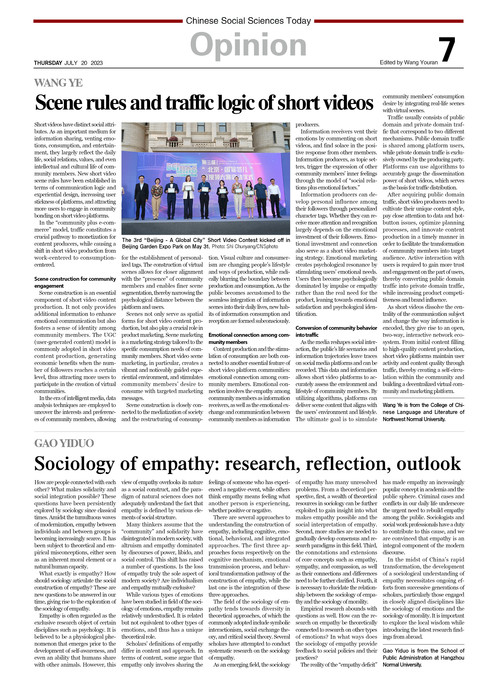Scene rules and traffic logic of short videos
2023-07-20 17:33:02
The 3rd “Beijing - A Global City” Short Video Contest kicked off in Beijing Garden Expo Park on May 31. Photo: Shi Chunyang/CNSphoto
Short videos have distinct social attributes. As an important medium for information sharing, venting emotions, consumption, and entertainment, they largely reflect the daily life, social relations, values, and even intellectual and cultural life of community members. New short video scene rules have been established in terms of communication logic and experiential design, increasing user stickness of platforms, and attracting more users to engage in community bonding on short video platforms.
In the “community plus e-commerce” model, traffic constitutes a crucial pathway to monetization for content producers, while causing a shift in short video production from work-centered to consumption-centered.
Scene construction for community engagement
Scene construction is an essential component of short video content production. It not only provides additional information to enhance emotional communication but also fosters a sense of identity among community members. The UGC (user-generated content) model is commonly adopted in short video content production, generating economic benefits when the number of followers reaches a certain level, thus attracting more users to participate in the creation of virtual communities.
In the era of intelligent media, data analysis techniques are employed to uncover the interests and preferences of community members, allowing for the establishment of personalized tags. The construction of virtual scenes allows for closer alignment with the “presence” of community members and enables finer scene segmentation, thereby narrowing the psychological distance between the platform and users.
Scenes not only serve as spatial forms for short video content production, but also play a crucial role in product marketing. Scene marketing is a marketing strategy tailored to the specific consumption needs of community members. Short video scene marketing, in particular, creates a vibrant and noticeably guided experiential environment, and stimulates community members’ desire to consume with targeted marketing messages.
Scene construction is closely connected to the mediatization of society and the restructuring of consumption. Visual culture and consumerism are changing people’s lifestyle and ways of production, while radically blurring the boundary between production and consumption. As the public becomes accustomed to the seamless integration of information scenes into their daily lives, new habits of information consumption and reception are formed subconsciously.
Emotional connection among community members
Content production and the stimulation of consumption are both connected to another essential feature of short video platform communities: emotional connection among community members. Emotional connection involves the empathy among community members as information receivers, as well as the emotional exchange and communication between community members as information producers.
Information receivers vent their emotions by commenting on short videos, and find solace in the positive response from other members. Information producers, as topic setters, trigger the expression of other community members’ inner feelings through the model of “social relations plus emotional factors.”
Information producers can develop personal influence among their followers through personalized character tags. Whether they can receive more attention and recognition largely depends on the emotional investment of their followers. Emotional investment and connection also serve as a short video marketing strategy. Emotional marketing creates psychological resonance by stimulating users’ emotional needs. Users then become psychologically dominated by impulse or empathy rather than the real need for the product, leaning towards emotional satisfaction and psychological identification.
Conversion of community behavior into traffic
As the media reshapes social interaction, the public’s life scenarios and information trajectories leave traces on social media platforms and can be recorded. This data and information allows short video platforms to accurately assess the environment and lifestyle of community members. By utilizing algorithms, platforms can deliver scene content that aligns with the users’ environment and lifestyle. The ultimate goal is to simulate community members’ consumption desire by integrating real-life scenes with virtual scenes.
Traffic usually consists of public domain and private domain traffic that correspond to two different mechanisms. Public domain traffic is shared among platform users, while private domain traffic is exclusively owned by the producing party. Platforms can use algorithms to accurately gauge the dissemination power of short videos, which serves as the basis for traffic distribution.
After acquiring public domain traffic, short video producers need to cultivate their unique content style, pay close attention to data and hot-button issues, optimize planning processes, and innovate content production in a timely manner in order to facilitate the transformation of community members into target audience. Active interaction with users is required to gain more trust and engagement on the part of users, thereby converting public domain traffic into private domain traffic, while increasing product competitiveness and brand influence.
As short videos dissolve the centrality of the communication subject and change the way information is encoded, they give rise to an open, two-way, interactive network ecosystem. From initial content filling to high-quality content production, short video platforms maintain user activity and content quality through traffic, thereby creating a self-circulation within the community and building a decentralized virtual community and marketing platform.
Wang Ye is from the College of Chinese Language and Literature of Northwest Normal University.


